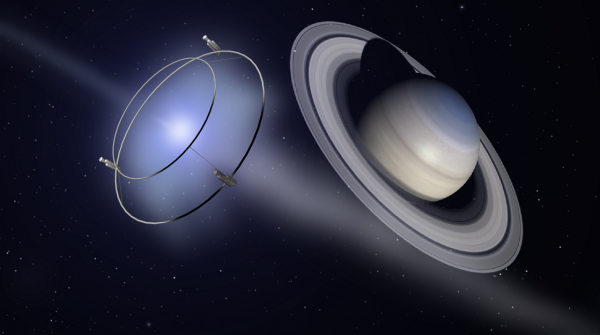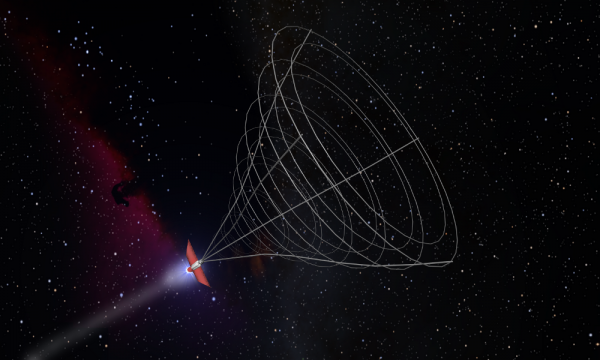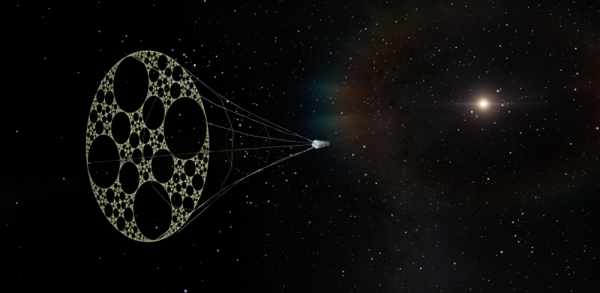BY LETTER
Magnetic Drive Sails
Technology > Application > Transportation > Interstellar Transport
Technology > Application > Transportation > Propulsion Technology
Technology > Application > Transportation > Ships
Technology > Application > Transportation > Propulsion Technology
Technology > Application > Transportation > Ships
Reconfigurable superconducting loop structures used to accelerate and decelerate spacecraft | |
 Image from Steve Bowers | |
| A triple loop magsail is accelerated near Jupiter. Three separate boostbeams transfer momentum to the rig, carefully avoiding the spacecraft itself, which is attached to the drivesail by a tether. | |
Many starships employ reconfigurable Magnetic Drive Sail technology to assist with acceleration and deceleration. First the drive sail will be configured as a large magsail to take advantage of Beamed Energy Propulsion and acquire momentum from a boostbeam in order to accelerate to a moderate percentage of light-speed. Magsails can be configured as single or multiple loops to take advantage of varying numbers of beams.
The drive sail can then switch over to become a magnetic ramscoop feeding a Conversion Drive to get up to cruising speed (often around 0.84c, sometimes faster). The drivesail can be reconfigured near the destination system as a magnetic brake to slow down to less than .01c.
Taken together these systems allow a starship to operate at a high fraction of lightspeed while carrying relatively small amounts of fuel. The drivesail takes on a number of different forms during this process, but often the resemblance to a sail, complete with shrouds and spars, is striking.
Magsail Configuration
 Image from Steve Bowers | |
| A single loop magsail with spacecraft hull structures spaced evenly around the loop. Many beamrider and cycler craft employ this sort of configuration. | |
The boostbeam system may be powered by energy from the local star, or from the fusion of ice extracted from Oort-cloud objects. To take advantage of the Oberth Effect many boostbeams are located near massive gas giants, and may obtain their power from the planet's magnetic field.
A small fraction of the beam passes directly through the centre of the magnetic field (which is shaped like a torus with a very small central hole). This forward pointing beam can be used to give the ship and sail some protection against dust impact.
Ramscoop Configuration
 Image from Steve Bowers | |
| To collect interstellar material efficiently the scoop must extend in a funnel shape forward of the spacecraft's intake system | |
To support the scoop, the drivesail must be supported by rigid spars. These can be formed using magnetic mass stream technology, although the magnetic fields required for dynamic compression members may conflict with the superconducting collection loops and reduce their effectiveness, More advanced versions use optical support members, suspending the sail on powerful lasers.
Matter collected by the scoop is partially converted into energy by monopole Conversion technology, and the rest is used as propellant, bringing the ship to a high fraction of the speed of light.
Magbrake Configuration
 Image from Steve Bowers | |
| To gain maximum traction against the thin interstellar medium, this magbrake design uses multiple superconducting loops arranged in a fractal pattern. | |
The earliest (unbuilt) magscoop designs were not efficient enough to produce enough thrust to overcome the drag of the interstellar medium. This drag is utilised to good effect in the magbrake configuration, allowing the ship to reduce its speed from eight-tenths of light speed to one percent of c. The ship then uses stored fuel to decelerate to orbital speeds.
Craft such as interstellar cyclers and many types of beamrider do not normally decelerate to orbital speed, but even these craft use magbrakes on occasion to regulate their velocity.
Note that the Magnetic Drive Sail should not be confused with the mythical Differential Sail, a form of hypothetical reactionless drive system that has been found to be unworkable in practice.
Related Articles
Appears in Topics
Development Notes
Text by Todd Drashner and Steve Bowers
some suggestions by Adam Crowl
Initially published on 25 February 2015.
The Magnetic Sail - Final Report to the NASA Institute of Advanced Concepts by Robert Zubrin and Andrew Martin
some suggestions by Adam Crowl
Initially published on 25 February 2015.
Further Information
Magnetic Sails versus Two-Stage Fusion Rockets by Adam CrowlThe Magnetic Sail - Final Report to the NASA Institute of Advanced Concepts by Robert Zubrin and Andrew Martin






